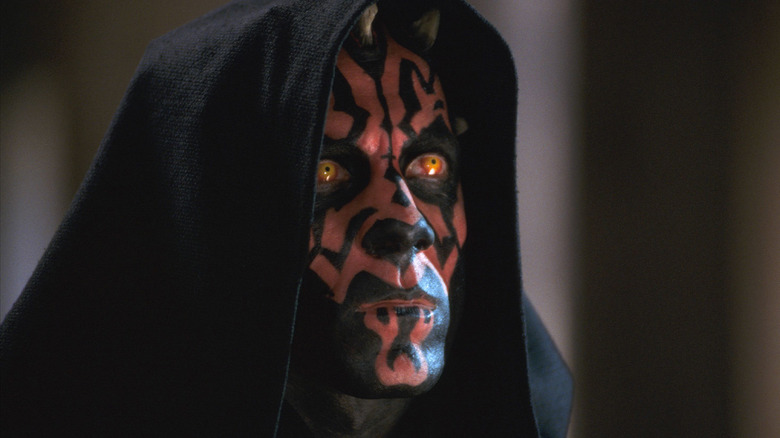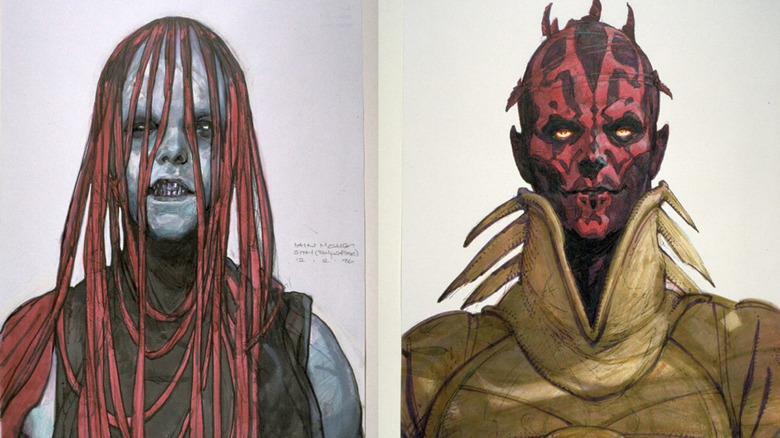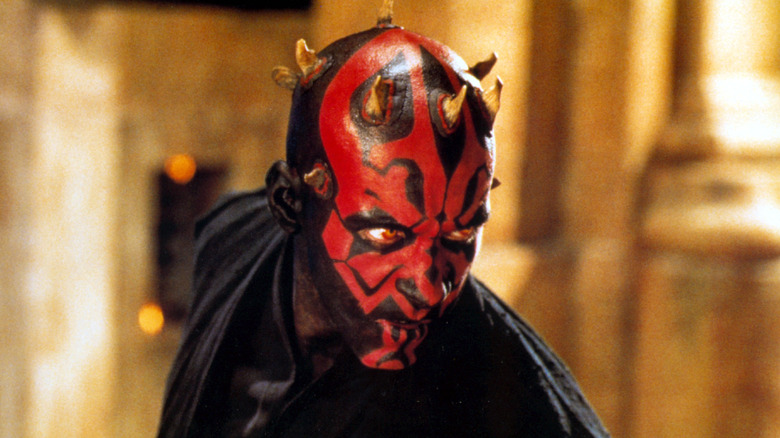The Real Reason Star Wars Villain Darth Maul Has Horns Is Hilarious
Within the "Star Wars" galaxy, few alien races are cooler than Zabraks. From their intricate facial tattoos to their cranial horns, there's really no species that looks quite so visually distinct (or, to be honest, more badass). They don't pop up often in the "Star Wars" saga, but when they do, they make a genuine impression. Take Darth Maul, played by Ray Park in "Star Wars: Episode I — The Phantom Menace." Though he's only appeared in live-action twice (the last time for a cameo in "Solo: A Star Wars Story" that never bore any fruit), he's become a fan favorite since. His popularity has a lot to do with his character design, which is at once utterly terrifying and totally unforgettable. He's a decisive highlight of the "Star Wars" prequels, and he ultimately became the blueprint for Zabraks and their subspecies.
As important as he's become to the franchise now, though, Maul's origins weren't auspicious. Creating the character was a massive exercise in trial and error for the Lucasfilm team. It took years to design the Sith Lord we all know and love, and even then, the best parts of Maul's look — his horns — happened entirely by accident.
'A vison from your worst nightmare'
Maul was created by Iain McCaig, a now-legendary artist who designed countless creatures and costumes for the "Star Wars" prequels. For "The Phantom Menace," McCaig's primary task was designing Maul and Queen Padmé Amidala, and it was a task he took seriously. "Darth Maul was the beast and [Padmé] was the beauty," McCaig told StarWars.com in 2019. "The scarier and gnarlier that Maul got, the more exotic and powerful she got."
Creating Padmé seemed to come easily for McCaig: ironically, he based his early designs on Natalie Portman, who would go on to play the character throughout the prequels. But the task of designing Maul was a much more arduous process. He was the first Sith that audiences would see after Darth Vader in the original trilogy, and trying to compete with his iconic helmet was causing a fair amount of anxiety. "Finally I decided, 'All right, well, heck, take that darn helmet off. Let's see what's underneath,'" McCaig recalled. Things got easier once the "Phantom Menace" script hit McCaig's desk, offering a clearer path for the designer:
"Darth Maul is described as 'a vision from your worst nightmare.' That was all I needed ... I drew my worst nightmare, which was that face that's peering in the window at you late at night, and it's barely alive. Like a cross between a ghost and a serial killer staring in at you, and it's raining, and the rain is distorting the face. So I drew that, a stylized version of it, red ribbons instead of rain, and put it in a folder, and at the meeting passed it over to George. George opened it up and went, "Oh, my God," slammed it shut, handed it back, and said, "Give me your second worst nightmare."
The birth of Darth Maul
McCaig's redesign was, hilariously, too scary for Lucas, which forced the designer back to the drawing board. McCaig had to find something slightly less disturbing, but it was important not to diminish the terror of Maul. Ultimately, he turned to more symbolic ideas of fear: "I looked for my first best mythological nightmare, and that's easy, because that's clowns. I was scared to death of Bozo the Clown as a kid."
McCaig recycled a concept he'd used in earlier designs of Maul, drawing patterns across his face that embodied light and shadow. "I put a Rorschach pattern on his face, and George seemed to respond to that really well," McCaig said. "The patterns became very stylized patterns of the muscles underneath the skin that give expression to the face."
He finished off Maul's new look with a headdress of black feathers — but as the design passed from the art department to creature effects, McCaig's plans got a bit lost in translation. Nick Dudman, who served as Creature Effects Supervisor on "The Phantom Menace," interpreted the feathers as horns, which paved the way for the Maul seen in the film. Fortunately, McCaig was perfectly fine with the change.
"I think that wonderful performance from Ray, put into that makeup, with Nick Dudman's awesome misunderstanding of my drawing — because I had given him black feathers, and he thought they were horns — is what created Darth Maul," McCaig said in hindsight. It does take a village to actually create something as sprawling as "Star Wars," but it's fascinating to see just how such an iconic character came to be.


